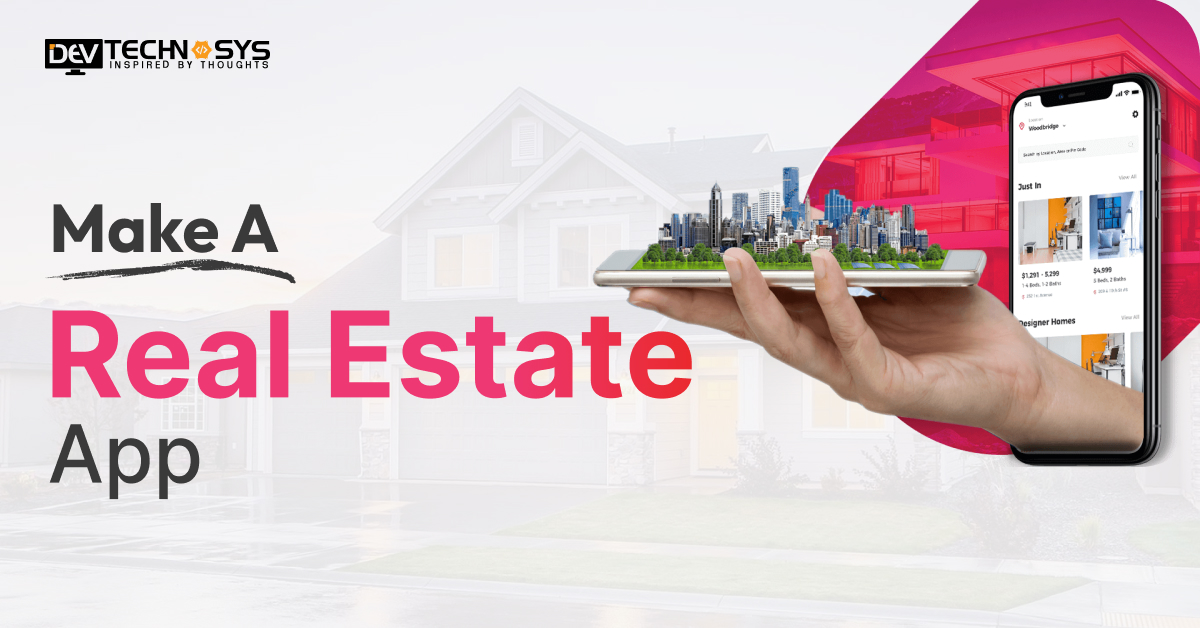“Buy. Sell. Rent”
Do you want to make a real estate app that helps people find homes fast and easily?
That’s awesome!
A real estate app is like a smart helper that shows houses, land, or shops people can buy or rent. It’s fun to build and can really help others.
But guess what?
It can also help you grow your business by turning listings into real leads! That means more people using your app and contacting you to buy or sell.
The increase from $654.39 trillion in 2025 to $727.80 trillion in 2029 highlights strong investment confidence in digital platforms reshaping the property buying, selling, and rental experience worldwide.
The above data clearly indicates that investing in real estate app development is a huge opportunity to grow your business.
In this blog, we explore how to make a real estate app that turns listings into leads and other useful information.
What is a Real Estate App?
A real estate app is a computer program that helps people buy, sell, rent, or take care of homes more efficiently. People who are buying, selling, renting, or working in real estate can use these apps on their phones, tablets, or computers, whenever and wherever they want, to ease the process of looking for and getting a home. An app like Aqar offers features such as property listings, video tours, price comparisons, mortgage tools, and ways to contact real estate agents.
- Property Listings
- Map Integration
- Mortgage Calculator
- Schedule Visits
Present and Future Statistics of Real Estate Applications
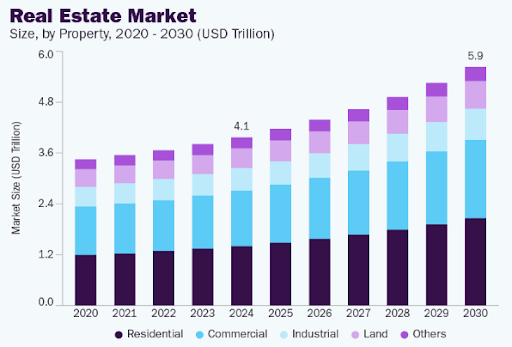
- The world’s real estate market is projected to be worth an amazing US$ 654.39 trillion by 2025.
- It is expected that the Residential Real Estate market will be worth US$ 534.37 trillion that same year, making it the biggest part of the business.
- Growth in the sector is projected to reach 2.69 percent per year from 2025 to 2029, reaching a market size of 727.80 trillion US dollars by that year.
- In a global sense, it’s important to note that the US real estate market is expected to bring in the most money, with a whopping US$ 136.6 trillion expected by 2025.
- Due to more people working from home, the real estate market in the United States is seeing a huge increase in demand for homes in the suburbs.
10 Trending Real Estate Applications
Find out about the 10 top real estate apps that are changing the way people buy, sell, and handle properties around the world with new features, easy-to-use interfaces, virtual tours, AI integration, and smooth digital experiences.
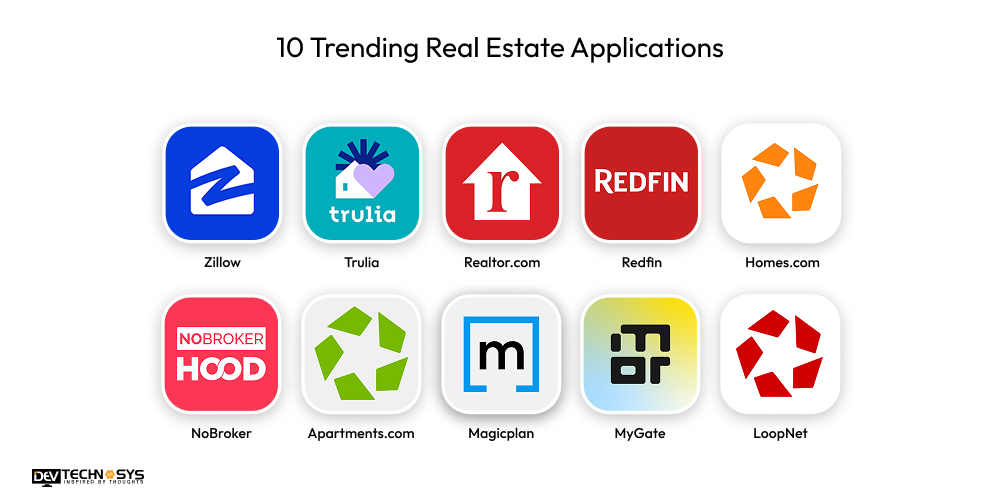
App Name |
Launch Year |
Downloads |
User Rating |
Platform Availability |
| Zillow | 2006 | 50M+ | 4.8 | iOS, Android, Web |
| Trulia | 2005 | 50M+ | 4.5 | iOS, Android, Web |
| Realtor.com | 2002 | 50M+ | 4.7 | iOS, Android, Web |
| Redfin | 2004 | 50M+ | 4.7 | iOS, Android, Web |
| Homes.com | 1998 | 50M+ | 4.3 | iOS, Android, Web |
| NoBroker | 2013 | 50M+ | 4.0 | iOS, Android, Web |
| Apartments.com | 1992 | 10M+ | 4.3 | iOS, Android, Web |
| Magicplan | 2011 | 10M+ | 4.5 | iOS, Android, Web |
| MyGate | 2016 | 3.5M+ | 4.4 | iOS, Android, Web |
| LoopNet | 2001 | 5M+ | 4.5 | iOS, Android, Web |
Why Businesses Want to Invest in Real Estate App Development?
Businesses are realizing the enormous potential of real estate app development services in UAE as the real estate sector undergoes a substantial digital shift. Here are five key reasons driving this investment:
- Increasing Market Demand
- Streamlined Operations and Efficiency
- Improved Customer Engagement
- Competitive Advantage
- Data Collection and Business Insights

1. Increasing Market Demand
With increased smartphone usage and internet connectivity, more people choose to search for properties using mobile applications rather than traditional ways. Real estate applications offer simplicity, speed, and a seamless experience, drawing a large user base that businesses may tap into.
2. Streamlined Operations and Efficiency
Many laborious procedures, such as property listing administration, customer contact, document processing, and appointment scheduling, may be automated using apps. This efficiency lowers operating costs, speeds up transaction times, and boosts overall productivity for real estate organizations.
3. Improved Customer Engagement
Real estate app development solutions in Dubai include interactive features such as virtual tours, real-time property updates, and personalized suggestions. These features increase user engagement, trust, and customer satisfaction, potentially leading to increased conversion rates and repeat business.
4. Competitive Advantage
Creating a high-quality real estate app distinguishes firms from the competition by emphasizing innovation and customer-focused solutions. A well-designed app improves brand awareness and trust, attracting tech-savvy customers and establishing leadership in a competitive sector.
5. Data Collection and Business Insights
Real estate mobile apps capture important user information, including search habits, preferences, and actions. Businesses may use this data to refine marketing campaigns, adapt property offers, and make educated decisions, resulting in more sales and a better return on investment.
How AI Can Help Real Estate Applications?
- AI analyzes user behavior to offer personalized property recommendations, enhancing search relevance and improving user satisfaction.
- AI-powered pricing models predict accurate property values based on market trends and property features, aiding better decision-making.
- Sentiment analysis on reviews and social media helps gauge neighborhood reputation and buyer preferences.
- Predictive analytics optimize marketing campaigns by targeting potential buyers more effectively, increasing conversion rates.
- Image recognition helps tag and categorize property photos automatically, speeding up listing management.
7 Essential Steps to Make a Real Estate App
Find out the important steps you need to take to make a successful real estate app, from researching the market and planning features to developing, testing, and releasing the app. This will give your business a powerful digital platform that improves the user experience and speeds up property deals.
- Market Research and Planning
- Define Features and App Design
- Choose the Technology Stack
- Develop the Backend
- Build the Frontend
- Testing and Quality Assurance
- Launch and Marketing
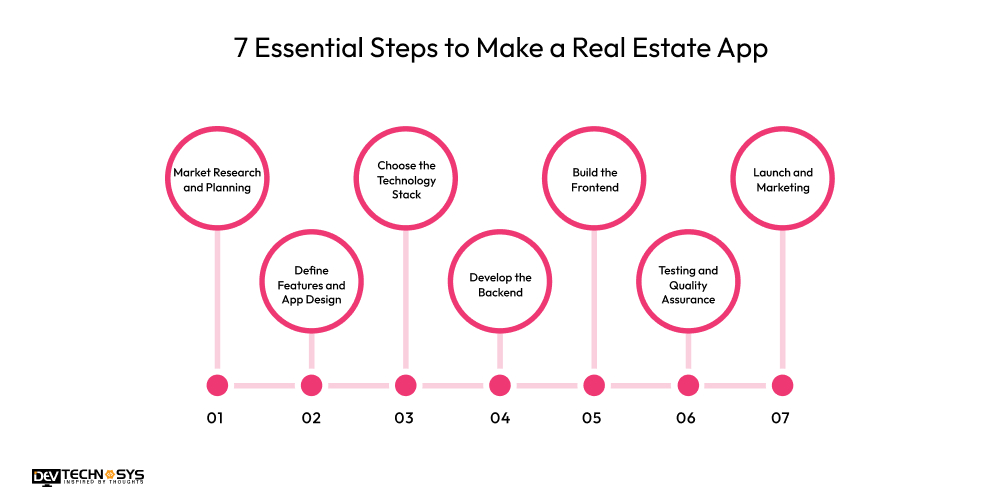
1. Market Research and Planning
Start by analyzing the real estate market, target audience, and competitors. Identify user needs, app features, and unique selling points. Hire app developers to develop a clear roadmap, budget, and timeline to guide the development process and ensure your app addresses market demands effectively.
| What are the main pain points users face in real estate searches? |
| Who is the target audience for the app? |
| Which competitors have successful real estate apps? |
2. Define Features and App Design
Outline essential features such as property listings, search filters, map integration, virtual tours, and user profiles. Collaborate with UI/UX designers to create intuitive, attractive wireframes and prototypes that deliver a smooth, engaging user experience aligned with your brand identity.
| Should the app support virtual tours or 3D walkthroughs? |
| How should the property listings be displayed? |
| How can the app’s design ensure easy navigation? |
3. Choose the Technology Stack
Hire an experienced developer from a mobile app development company in UAE to select suitable programming languages, frameworks, and tools for both front-end and back-end development. Consider cross-platform options like React Native or Flutter to build apps for iOS and Android efficiently, ensuring scalability, performance, and security in the app’s architecture.
| Which programming languages suit front-end development best? |
| Should we build a native or cross-platform app? |
| Which database is ideal for handling property data? |
4. Develop the Backend
Set up servers, databases, and APIs to manage user data, property listings, search functionalities, and notifications. Focus on building a robust, scalable backend that supports smooth data flow and integrates with third-party services like maps, payment gateways, and authentication systems.
| How will user data be securely stored and managed? |
| How will the backend handle search queries efficiently? |
| How will we manage user authentication and authorization? |
5. Build the Frontend
Move to fifth stage of real estate iOS app development in UAE, create the user interface based on your design prototypes, implementing interactive elements and integrating backend functionalities. Ensure responsiveness and seamless navigation across devices, prioritizing speed and accessibility for a positive user experience.
| How will the user interface align with the app’s branding? |
| What framework or library will be used for frontend development? |
| How will property listings and images be displayed visually? |
6. Testing and Quality Assurance
Conduct thorough testing to identify bugs, performance issues, and usability gaps. Use manual and automated testing methods to ensure the app functions smoothly, is secure, and meets all functional requirements before launch, reducing the risk of user dissatisfaction.
| What types of testing will be performed (manual, automated)? |
| How will we test app performance under load? |
| How will we test compatibility across devices and OS versions? |
7. Launch and Marketing
Publish your app on relevant platforms like the Apple App Store and Google Play Store. Plan a marketing campaign involving social media, SEO, and partnerships to attract users. Monitor user feedback and analytics for continuous improvement and updates.
| Which app stores will we launch on first? |
| How will we optimize the app store listing for visibility? |
| What budget is allocated for marketing campaigns? |
10 Normal and Advanced Features of Real Estate Applications
These features make the app experience better, make it easier to look for properties, and speed up the buying and selling process. This makes apps essential for buyers, owners, and agents alike.

1. Property Listings
Provide thorough listings with photographs, pricing, descriptions, and other important information to assist consumers in exploring available properties.
2. Advanced Search Filters
Allow visitors to narrow their searches by location, price, home type, size, bedrooms, and amenities for speedier results.
3. Interactive Maps
Show property locations on maps, together with surrounding facilities such as schools, hospitals, and transportation, to provide more context.
4. Virtual Tours
Provide 3D walkthroughs or 360-degree views so that consumers may examine properties remotely before booking appointments.
5. Favorites & Shortlists
Allow consumers to store and compare their favorite homes, making decision-making simpler and more structured.
6. Push Notifications
Send out notifications for new listings, price changes, and updates to keep users updated in real time.
7. Mortgage Calculators
Provide tools for estimating loan installments, interest rates, and affordability, allowing users to better plan their finances.
8. Agent Communication
To speed up queries, allow for direct interaction with agents or sellers through in-app calls, texts, or emails.
9. User Profiles
Allow users to set up accounts to remember preferences, monitor searches, and receive tailored suggestions.
10. Secure Document Sharing
Enable safe uploading and sharing of crucial documents, facilitating transactions such as leasing agreements and purchase contracts.
What is the Cost to Make a Real Estate App?
The cost to build a real estate app varies widely based on features, platform, and complexity. A basic app with essential features like property listings and search filters can cost between $8,000 and $15,000. More advanced apps, including virtual tours, AI-based recommendations, and backend integrations, may range from $18,000 to $25,000 or more. Factors like design, development team location, and maintenance also impact the cost to develop a real estate app. Overall, investing in a quality app ensures a better user experience and long-term growth in the competitive real estate market.
Cost to Develop a Real Estate App
Real Estate App Development |
Estimated Cost |
Time Frame |
| Basic Mobile App Development | $8000 – $12000 | 2 to 4 Months |
| Mid-Premium Mobile App Development | $13000 – $21000 | 4 to 8 Months |
| High-Premium Mobile App Development | $25000+ | 9+ Months |
What Are the Crucial Factors That Can Affect the Real Estate App Development Cost?
Learn about the main things that affect the cost of develop a mobile app, like the number of features, the platform chosen, the design needs, the location of the development team, the need for integration, and the need for upkeep. This will help businesses make the best budget for a successful, scalable, and user-friendly app.

1. Feature Complexity
The diversity and sophistication of app features have a significant influence on development costs. Basic services like property listings and search filters are less expensive, but complex functions like virtual tours, AI suggestions, real-time chat, and analytics demand more time and skill, dramatically raising overall expenditures.
Feature Type |
Description |
Estimated Cost (USD) |
| Basic Features | Property listings, search filters | $5,000 – $8,000 |
| Intermediate Features | Virtual tours, notifications, favorites | $8,000 – $13,000 |
| Advanced Features | AI recommendations, chatbots, analytics | $14,000 – $19,000 |
2. Design Customization
Design customisation relates to how personalized the app’s user interface is. Using common templates saves money but provides less originality. Custom UI/UX design, which includes branded images and user-friendly layouts, necessitates expert designers and additional time, increasing user engagement but rising real estate app development costs.
Design Level |
Description |
Estimated Cost Range (USD) |
| Template-Based Design | Pre-made UI with minimal customization | $2,000 – $3,500 |
| Custom UI/UX Design | Unique, branded, user-friendly design | $4,000 – $7,500 |
3. Platform Choice
The cost to develop a house finder app depends on whether you use iOS, Android, or both. Developing for a single platform is less expensive than designing cross-platform apps with frameworks like React Native or Flutter, which support numerous devices but demand more resources. Adding a web app raises expenses owing to additional development and maintenance requirements.
Platform |
Details |
Estimated Cost (USD) |
| Single Platform | iOS or Android only | $5,000 – $11,000 |
| Cross-Platform | React Native, Flutter (iOS + Android) | $12,000 – $17,000 |
| Web + Mobile | Web app plus native mobile apps | $17,000 – $22,000 |
4. Backend Infrastructure
Backend infrastructure consists of servers, databases, APIs, and cloud services that enable app functionality. A basic backend with less data processing costs less. Complex backends with scalable architecture, real-time data synchronization, and strong security mechanisms necessitate extensive development efforts, greatly increasing real estate app Development cost.
Infrastructure Type |
Description |
Estimated Cost (USD) |
| Basic Server Setup | Simple database and server | $3,000 – $6,000 |
| Scalable Backend | Cloud hosting, load balancing, APIs | $6,000 – $9,000 |
| Complex Systems | Real-time data, advanced security | $10,000 – $16,000 |
5. Third-Party Integrations
Integrating external services such as maps, payment gateways, authentication, and analytics tools improves functionality while increasing cost to maintain an app. Basic API interfaces are reasonably priced; however, extensive integrations with CRM systems, AI tools, or complicated data analytics need more customization and incur more costs.
Integration Type |
Examples |
Estimated Cost (USD) |
| Basic APIs | Maps, payment gateways, and authentication | $2,000 – $5,000 |
| Advanced Integrations | CRM, AI tools, analytics platforms | $5,000 – $10,000 |
How to Generate Money From Real Estate Applications?
Combining these ways to make money, real estate apps in UAE can build long-term revenue lines while still providing value to buyers, sellers, and pros in the field. Picking the right mix relies on the app’s features, target group, and the competition. This will help it stay profitable and grow over time.
- Freemium Model
- In-App Advertising
- Listing Fees
- Lead Generation
- Data Analytics and Market Insights
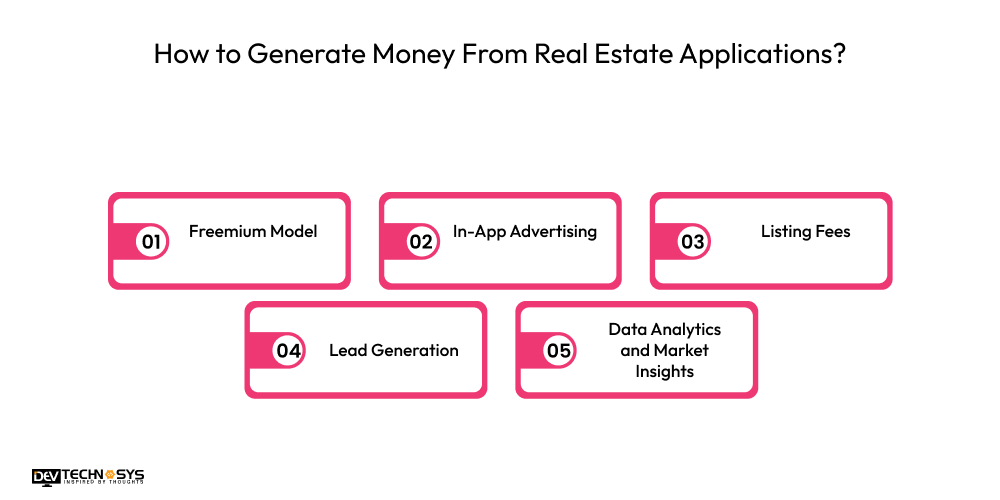
1. Freemium Model
Many real estate applications provide basic functionality for free and charge customers for premium services. Advanced search criteria, virtual tours, and early access to postings are all available as part of a membership or one-time purchase. This approach has a big user base and monetizes power users.
2. In-App Advertising
Displaying targeted advertising from real estate agents, mortgage lenders, home renovation services, or local companies might result in consistent revenue. Ads can appear as banners, sponsored listings, or video ads that are carefully calibrated to prevent disturbing the user experience.
3. Listing Fees
Charging property sellers, real estate agents, or brokers to list their homes on the app is a popular income stream. Fees might vary depending on listing duration, priority placement, and the amount of listings, making it a variable source of income.
4. Lead Generation
Real estate Android app development solution in Dubai may make money by linking buyers with real estate agents, mortgage lenders, and house inspectors. When a customer uses a recommended service through the app, the platform receives a commission or referral fee, resulting in a win-win situation.
5. Data Analytics and Market Insights
Real estate applications capture a large quantity of user and market data. Offering anonymous data reports, market trends, and predictive analytics to real estate corporations, investors, and developers may be a profitable business strategy. This data enables clients to make more educated decisions while also providing an extra income stream.
Conclusion
To make a real estate app that turns listings into leads, it’s important to focus on easy search, clear property details, and quick communication tools. A good design helps users find what they want fast. Working with a skilled real estate app development company can make this process easier and ensure the app works smoothly. With the right features and expert help, your app can attract more users and turn listings into real customers successfully.
Frequently Asked Questions
1. How Much Does it Cost to Make a Real Estate App?
The cost to build a real estate app ranges from $8,000 to $25,000+, depending on features, design complexity, platforms, backend needs, and third-party integrations.
2. How Long Does It Take to Create a Real Estate App?
To create a real estate app, it basically takes 3 to 6 months, depending on feature complexity, design requirements, platform choice, backend development, and testing phases. More advanced apps with custom features may require additional time.
3. Which Technologies Are Used to Develop a Real Estate App?
To develop a real estate app, use technologies like React Native or Flutter for cross-platform development, Node.js or Django for backend, MongoDB or MySQL databases, Google Maps API for location services, and cloud platforms like AWS or Firebase for hosting.
4. What Analytics Tools Should I Use to Track User Behavior and Leads?
To track user behavior and leads in a real estate app, use analytics tools like Google Analytics, Mixpanel, Firebase Analytics, Amplitude, and Hotjar. These provide insights on user actions, engagement, and conversion metrics for better decision-making.
5. What’s the Best Way to Monetize a Lead-Generating Real Estate App?
The best way to monetize a lead-generating real estate app is through subscription plans, paid property listings, targeted advertising, referral commissions, and premium features that offer advanced tools or priority access to high-quality leads.



